Researchers and scientists understand why there is a growing interest in cannabinoids and their potential health benefits, and it’s for a good reason. People are looking for natural alternatives to traditional prescription drugs that may be accompanied by unwanted side effects.
Marijuana doctors and medical card clinics are frequently asked about which cannabinoids to take and which ones would be most beneficial for their underlying health conditions. Then, there are recreational users that want to know which cannabinoids will help them achieve the best “high.”

What if I told you that the secret key to unlocking wellness may reside in the grandeur of modern pharmaceutical science and nature’s intricate biological tapestry?
Enter the realm of cannabinoids and phytocannabinoids, two families of compounds with profound influences on the human body. But here’s the catch – they are not identical twins.
What is the difference between cannabinoids and phytocannabinoids?
Unraveling the Enigma of Cannabinoids and Phytocannabinoids
What are cannabinoids?
Cannabinoids, a term you might have stumbled upon while sifting through medicinal science news or perhaps a casual CBD ad, are a group of active compounds found predominantly in the Cannabis plant. They’ve gained recognition for their ability to influence the human body’s endocannabinoid system (ECS), a complex network that keeps our physiological processes in check.
The two most well-known cannabinoids—
- THC, which causes psychoactive effects, and
- CBD, famed for its health benefits—are just two faces in the crowd of over 100 cannabinoids.
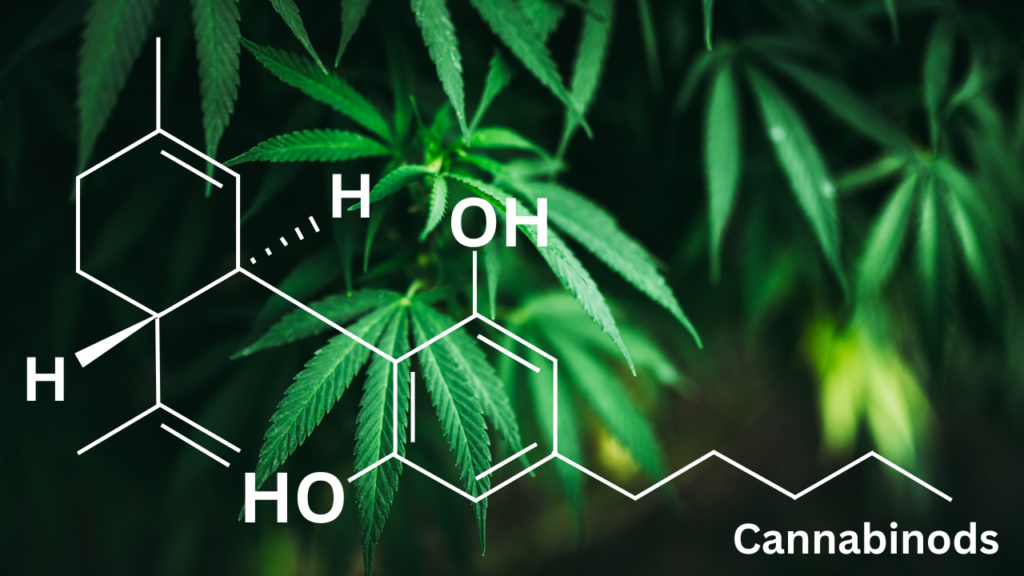
What are phytocannabinoids?
By definition, they are plant-produced cannabinoids. To say phytocannabinoids and cannabinoids are the same would be like saying all dogs are poodles or all squares are rectangles, but not all rectangles are squares. All phytocannabinoids are cannabinoids, but not all cannabinoids are phytocannabinoids.
Our bodies are remarkable biochemical factories capable of producing endocannabinoids—human-made cannabinoids. They mirror the structure and function of plant-derived cannabinoids; hence, the term ‘phytocannabinoid’ was coined to delineate these plant-synthesized versions.
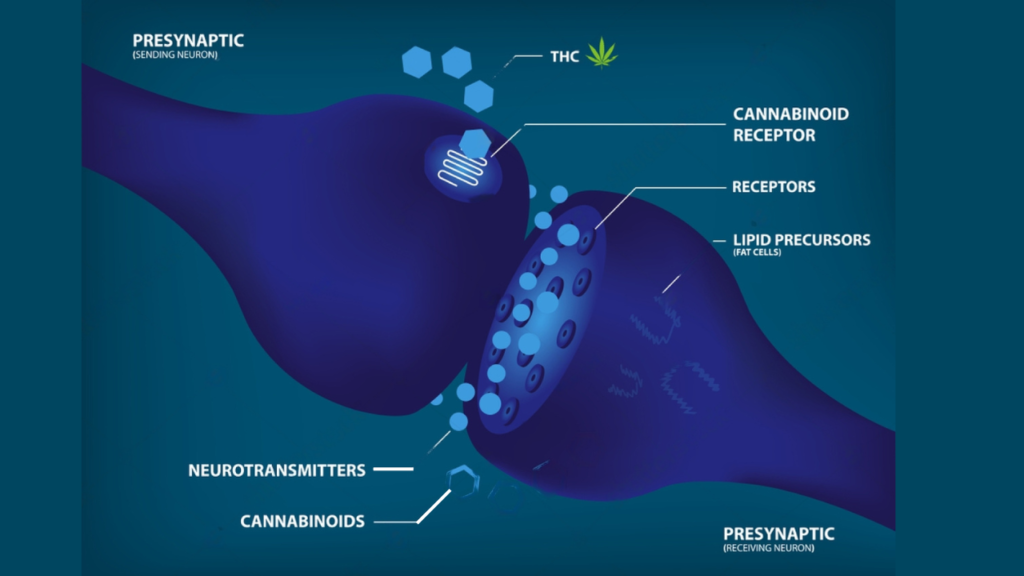
Four (4) FDA-Approved Drug Made From Cannabinoids
The first ever FDA-approved drug derived from a phytocannabinoid called. It is derived from cannabidiol, otherwise known as CBD and is the primary active ingredient:
- Epidiolex (cannabidiol)
Three (3) FDA-approved drugs derived from synthetic cannabinoids:
- Marinol (dronabinol)
- Syndros (dronabinol)
- Cesamet (nabilone)
Enter The Mysterious World of Cannabinoids and Phytocannabinoids,
Steeped in complexity yet brimming with potential, is a treasure trove for scientific exploration and personal health journeys. As we continue to decode their mysteries, remember that knowledge is power, and it’s time we harness this power to unlock the secret doors of well-being.
This might be your “aha” moment—a realization about the intricate beauty of nature and its profound connection to our well-being. Share this eye-opener with your friends and loved ones. Let’s start a conversation that could forever change our understanding of health and wellness. Stay curious, stay enlightened, and above all, stay healthy. For the purpose of this article, we will place an emphasis on phytocannabinoids, nature’s cannabinoid compounds found in cannabis plants. Interest in these compounds has grown exponentially in recent years.
This detailed review will introduce you to the top 22 cannabinoids and explore their potential health benefits based on scientific studies.
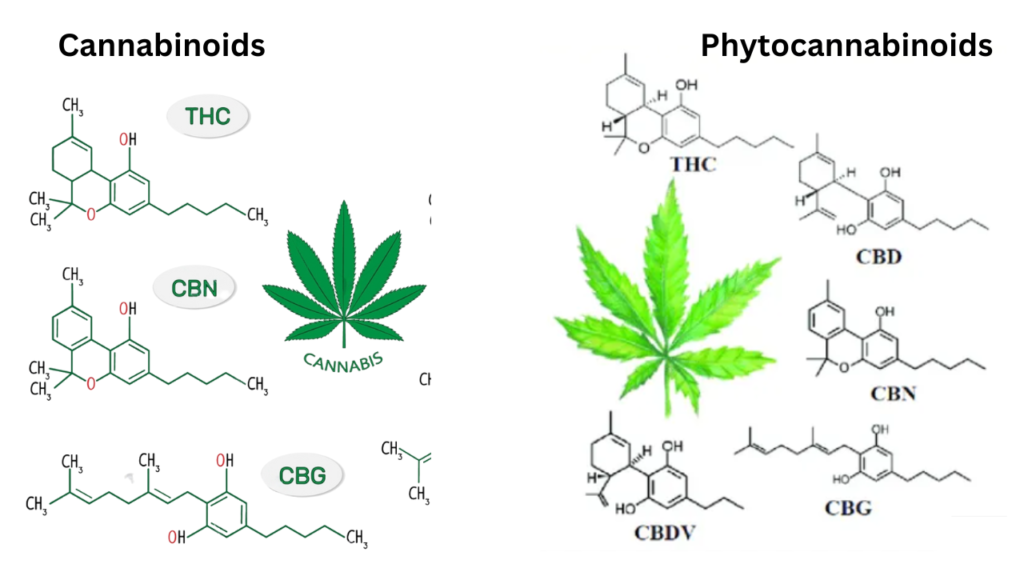
Discover the exciting world of cannabinoids!
How Many Classifications of Cannabinoids Are There?
3 Classifications of Cannabinoids
- Phytocannabinoids: Are produced naturally in the cannabis plant.
- Endocannabinoids: Are produced naturally by the body. The two most studied are Anandamide (AEA) and 2-arachidonoylglycerol (2-AG)
- Synthetic cannabinoids: man-made chemicals that mimic the effects of natural cannabinoids. Often used in research. Some synthetic cannabinoids are also used in legal and illegal drugs.
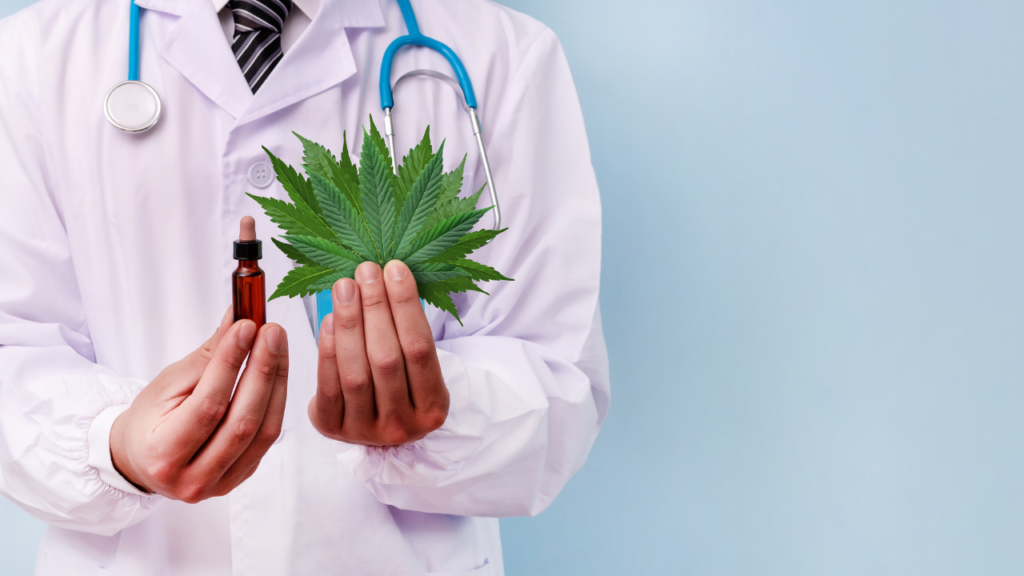
What Are Cannabinoid Acids?
Cannabinoid acids are the precursors to the cannabinoids most people are familiar with, such as THC and CBD. They are converted into these more familiar compounds through a process called decarboxylation, which typically involves heating the substance. Each of these cannabinoid acids has unique properties, and many are being researched for potential therapeutic benefits.
Phytocannabinoids Are Derived From Cannabinoid Acids Through a Process Known as Decarboxylation.

Will Eating Raw Marijuana Get You "High?"
No, consuming unprocessed or unheated weed will not get you high. The question most people have is why?
In its natural, unprocessed state, the cannabis plant doesn’t actually contain substantial amounts of THC. Instead, it contains a substance called tetrahydrocannabinolic acid (THCA), which is a non-psychoactive precursor to THC.
THCA does not produce a “high” because it doesn’t interact with the body’s endocannabinoid system in the same way that THC does. In order to convert THCA into the psychoactive THC, a process called decarboxylation must occur.
THCA Has To Be Converted into THC For Psychoactive Effects
If a person consumes unprocessed, raw cannabis, they wouldn’t experience the psychoactive effects typically associated with marijuana, because the THCA has not been converted into THC. In fact, some people consume raw cannabis for a plethora of other potential therapeutic benefits particularly when they want the health benefits without the psychoactive effects.
What are The Health Benefits of Eating Raw Cannabis?
What is Decarboxylation?
It’s a chemical process that activates the psychoactive and therapeutic properties of cannabis. For example, if you ate raw marijuana flowers (buds), you wouldn’t get “high” because they are not active in this state, meaning they won’t produce the effects typically associated with cannabis.
When cannabis is decarboxylated, it’s heated to a specific temperature for a certain length of time, which triggers a chemical reaction that removes a carboxyl group from these compounds. This procedure transforms THCA into THC and CBDA into CBD, activating the chemicals and enabling them to interact with the endocannabinoid system of the body to produce their range of effects.
Decarboxylation happens when you smoke or vaporize cannabis or when it is done intentionally to make edibles and other cannabis products to ensure they have the desired effects.
After Decarboxylation Cannabinoid Acids Transform Into its Respective Cannabinoid Compounds:
- Cannabigerolic acid (CBGA) ——–> Cannabigerol (CBG)
- Δ9-tetrahydrocannabinolic acid (THCA) ——–> Δ9–tetrahydrocannabinol (THC)
- Cannabidiolic acid (CBDA) ——–> Cannabichromevarin (CBCV)
- Cannabichromenenic acid (CBCA) ——–> Cannabidiol (CBD)
- Cannabigerovarinic acid (CBGVA) ———> Cannabichromene (CBC)
- Tetrahydrocanabivarinic acid (THCVA) ———> Cannabigerivarin (CBGV)
- Cannabidivarinic acid (CBDVA) ———> Tetrahydrocannabivarin (THCV)
- Cannabichromevarinic acid (CBCVA) ———> Cannabidivarin (CBDV)
Are There health Benefits To Consuming Raw Cannabis?
Yes, despite raw cannabis not being decarboxylated raw cannabinoids offer many potential health benefits. Here are some potential health benefits from consuming raw cannabis:
10 Health Benefits Of Consuming Raw Cannabis

- Anti-Inflammatory Properties: Cannabidiolic acid (CBDA), the raw form of CBD, has been shown in some studies to have anti-inflammatory effects, which could be beneficial for conditions like arthritis or Crohn’s disease.
- Neuroprotective Properties: Some research suggests that cannabinoid acids may have neuroprotective effects, which could potentially be beneficial for conditions like Alzheimer’s disease.
- Nausea and Appetite: Preliminary research suggests that THCA may have anti-nausea effects. Some people also claim that raw cannabis helps stimulate their appetite, although this has not been scientifically validated.
- Bone Health: Some studies suggest that cannabinoids might help promote bone health and healing. Raw Cannabis is high in vitamin K and calcium which are essential for building bones.
- Antioxidant Properties: Cannabinoids, including those in raw cannabis, are known to have antioxidant effects, which means they can help combat oxidative stress in the body.
- Non-Psychoactive: Because the THC in raw cannabis is in its acidic form (THCA), it doesn’t have the psychoactive effects that THC does. This means that consuming raw cannabis won’t produce a “high.”
- Immune System: Raw cannabis has high traces of vitamin C which is essential for the immune systems.
- Healthy Blood: There are high levels of iron in raw cannabis which is critical for blood oxygenation.
- Regulating DNA biosynthesis: Cannabis in the raw is high in folate which maintains genomic stability.
- Potential To Fight Cancer: In experimental research conducted on live animals, scientists discovered that the cannabinoids present in THC could specifically target and effectively eradicate cancer cells.
Coincidentally many of the health benefits are similar to consuming cannabis that has been decarboxylated.
It’s also worth noting that while raw cannabis does not produce a “high,” it could still potentially cause side effects or drug interactions, so it’s always best to consult with a healthcare provider before trying a new health product or supplement.
There are at least 113 Cannabinoids Found in cannabis

Top 22 Cannabinoids And Their Potential Health Benefits
1. Cannabidiol (CBD): The Powerhouse Cannabinoid

CBD is one of the most well-known cannabinoids and has gained significant popularity for its potential therapeutic properties. If you thought the world of cannabinoids was just a THC-dominated landscape, it’s time to rethink. Among our list of the top 22 cannabinoids, Cannabidiol, popularly known as CBD, undeniably reigns supreme as the multifaceted marvel of the Cannabis plant. Unlike its notorious cousin, THC, CBD won’t induce any psychedelic experiences. Instead, it brings an impressive dossier of potential health benefits without the “high.” From anecdotal stories to emerging scientific evidence, CBD is steadily transforming from an enigmatic molecule into a therapeutic protagonist. Its influence spans from managing anxiety and inflammation to alleviating chronic pain and possibly even bolstering heart health. Intrigued? You should be. This superstar cannabinoid is revolutionizing our understanding of nature’s therapeutic arsenal. As we dive deeper into our exploration of the other top 22 cannabinoids, stick around to uncover the fascinating layers of CBD.
The journey through the hidden benefits of CBD might offer you the key to unlocking the wellness you’ve been searching for. Prepare for an enlightening voyage as we demystify CBD’s potential and potentially embrace it in your health regimen.
Research suggests that CBD may help with the following:
- Pain relief: CBD has been studied for its analgesic properties, potentially relieving chronic pain conditions. It’s frequently used for pain management.
- Reducing anxiety, stress, and depression: Studies have shown that CBD may have anxiolytic and antidepressant effects, offering relief for individuals with anxiety or depression disorders.
- Anti-inflammatory properties: CBD may help reduce inflammation, benefiting conditions like arthritis.
- Epilepsy treatment: EPIDIOLEX was the first plant-derived FDA-approved prescription medicine made from cannabidiol (CBD) to treat seizures associated with Lennox-Gastaut syndrome (LGS) and Dravet syndrome, which are rare forms of epileptic disorders classified as epileptic encephalopathies. The drug was approved on June, 2018.
2. Tetrahydrocannabinol (THC): The Pioneer Cannabinoid That Gets Users “High”

THC, the most well-known cannabinoid, is mainly responsible for the psychoactive effects of cannabis. Perched at the pinnacle of the cannabinoid family tree, THC is the proverbial elephant in the room when we talk about Cannabis. But beyond its famed psychoactive prowess lies a potential goldmine of health benefits waiting to be tapped. Often misunderstood and surrounded by stigma, THC is not just about the “high,” at least for those that consume it for medical purposes. It’s the pioneering cannabinoid that has been at the heart of groundbreaking research, exploring potential benefits ranging from pain relief to neuroprotection. The twist in the tale? THC’s effectiveness is not just a solitary act; it’s part of an entourage effect, where it works in synergy with other cannabinoids to enhance their collective therapeutic potential. Intrigued? We’ve piqued your curiosity for a good reason. In our journey through the top 22 cannabinoids, THC’s story is a pivotal chapter you don’t want to skip.
Buckle up as we dive deeper into the enigmatic world of THC, challenging preconceived notions and revealing its potential health benefits that could revolutionize your wellness journey. Discover, deliberate, and decide as you learn about THC’s therapeutic potential and its role in your health.
Some potential health benefits include:
- Pain management: THC may help alleviate pain, particularly in multiple sclerosis and neuropathic pain.
- Nausea and vomiting relief: Studies have shown that THC can effectively reduce nausea and vomiting, especially in cancer patients undergoing chemotherapy.
- Improve appetite: THC may stimulate appetite, making it useful for individuals with eating disorders or those undergoing treatments that suppress appetite.
- Muscle spasticity reduction: marijuana has been shown to reduce muscle spasticity.
3. Cannabigerol (CBG): The Unsung Hero of Cannabinoids
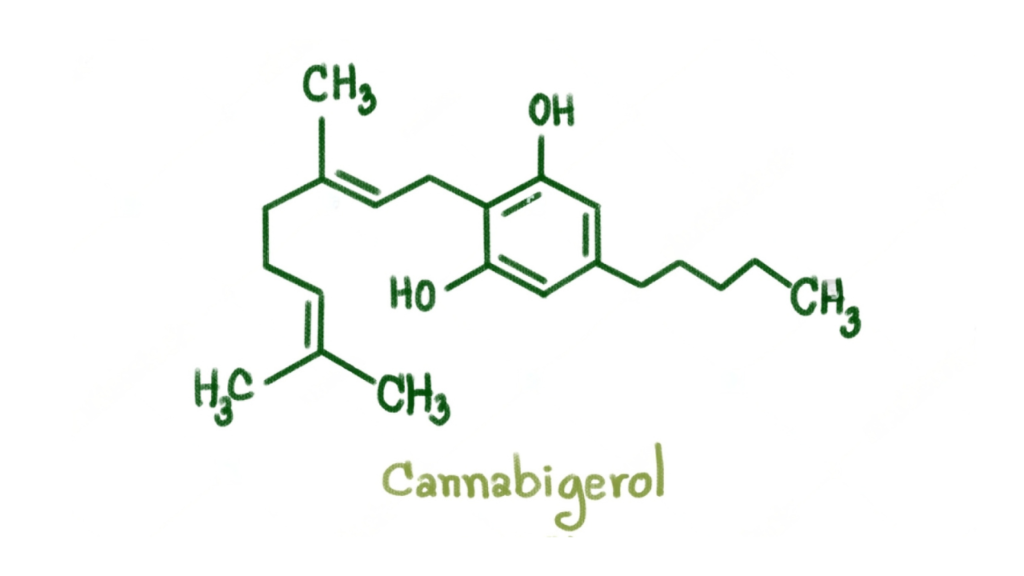
CBG is a non-intoxicating cannabinoid that shows promise in various health aspects. In the cannabinoid galaxy, certain stars tend to steal the limelight, but let’s now turn our telescopes towards Cannabigerol (CBG), the unsung hero, the “mother” of cannabinoids. CBG may not be as well-known as THC or CBD, but don’t let its low-key status fool you. It is the pioneering compound from which other cannabinoids are synthesized, making it a fundamental cornerstone in the cannabis plant’s biological symphony. Emerging research is shedding light on CBG’s potential health benefits, hinting at applications ranging from pain management to neuroprotection. And the best part? CBG doesn’t come with the psychotropic effects associated with THC. This makes it a promising therapeutic candidate for those seeking health benefits without the ‘high.” Curious to know more? You’ve just unlocked the doorway to the lesser-known yet fascinating world of CBG. As we traverse the vast terrain of the top 22 cannabinoids, the journey of CBG is an explorative ride you won’t want to miss.
Keep scrolling to venture deeper into the realm of CBG and dive into the treasure trove of information we’ve curated for you about CBG and its potential to revolutionize health and wellness as we know it.
Potential health benefits of CBG include:
- Neuroprotective properties: CBG has demonstrated neuroprotective effects, suggesting potential therapeutic applications for neurodegenerative disorders. CBG displayed efficacy in models of epilepsy and Huntington’s disease.
- Antibacterial activity: CBG has been found to have antibacterial properties, which could help fight against drug-resistant bacteria.
- Glaucoma management: Research suggests that CBG may help reduce intraocular pressure, which benefits people with glaucoma.
- Anti-inflammatory effects
- Anti Cancer/Anti Tumor properties
4. Cannabinol (CBN)
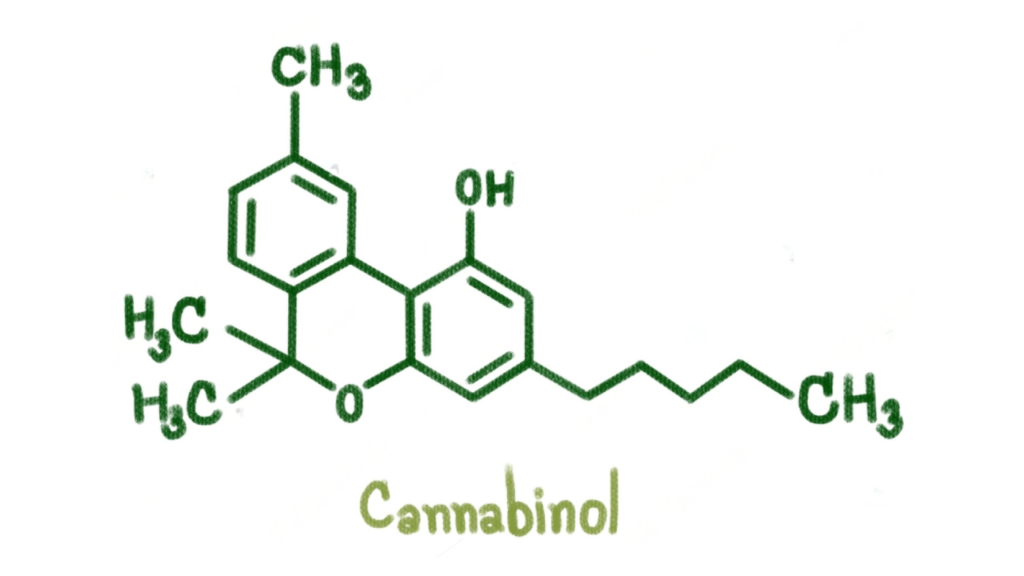
Demystifying Cannabinol (CBN): The Sleeper Star of Cannabinoids
CBN is a mildly psychoactive cannabinoid that forms as THC degrades over time. In the ever-evolving panorama of cannabis research, a new player has sparked intrigue — CBN. Often overlooked in favor of its more famous siblings, THC and CBD, CBN is stepping out from the shadows, armed with unique attributes that could redefine our perception of cannabinoids. Unlike THC, CBN won’t send you on a psychedelic journey, nor does it have the widespread popularity of CBD or THC. Instead,
CBN is carving its niche as the “nighttime cannabinoid,” showing promising potential for influencing sleep patterns.
Here are some of the potential health benefits:
- Sleep aid: CBN has shown promising effects as a sleep aid, potentially helping individuals with insomnia or sleep disorders.
- Appetite stimulation: Similar to THC, CBN may stimulate appetite, making it beneficial for individuals with reduced appetite.
- Antibacterial properties: CBN has been found to exhibit antibacterial effects against certain strains of bacteria.
5. Cannabichromene (CBC): Discovering The Understudied Wonder Cannabinoid
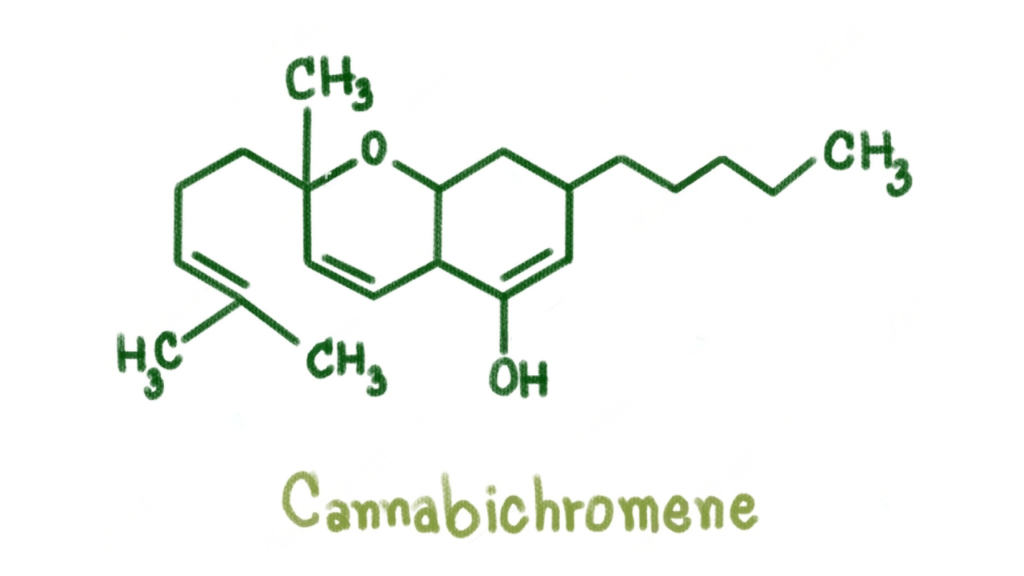
CBC is a non-intoxicating cannabinoid with promise in various health applications. As we travel the captivating landscape of the top 22 cannabinoids, we spotlight a lesser-known yet profoundly interesting member: Cannabichromene, or CBC. Though it hasn’t yet garnered the mainstream attention of THC or CBD, this understudied cannabinoid is slowly but surely stepping out of the shadows, hinting at a wealth of untapped potential. Preliminary research suggests that CBC may have a seat at the table for promoting brain health, as it appears to encourage neurogenesis, the process of creating new brain cells. You read that right: a cannabinoid might help grow more possibilities for your brain! Moreover, it’s believed to have potent anti-inflammatory and analgesic properties, setting the stage for potential applications in pain management and other health conditions.
If you find this intriguing, you’re not alone. The story of CBC is just beginning to unfold, and we’re at the precipice of an exciting new frontier in cannabinoid research.As we deliver the research on the fascinating world of CBC and peel back the layers of this wonder cannabinoid to help you on your wellness journey, consider how it might be helpful to your health. The universe of cannabinoids is expanding, and the tale of CBC is a page-turner you won’t want to miss.
Some potential benefits of CBC include:
- Anti-inflammatory effects: CBC has demonstrated anti-inflammatory properties, suggesting its potential use in inflammatory conditions.
- Pain relief: Studies indicate that CBC may provide pain-relieving effects, potentially contributing to chronic pain management.
- Antidepressant effects: Research suggests that CBC may have antidepressant properties, potentially relieving depression in some individuals.
- CBC showed promising results in models of Parkinson’s and Huntington’s diseases, hypomobility, and seizures.
6. Cannabidivarin (CBDV): The Dark Horse of Cannabinoids
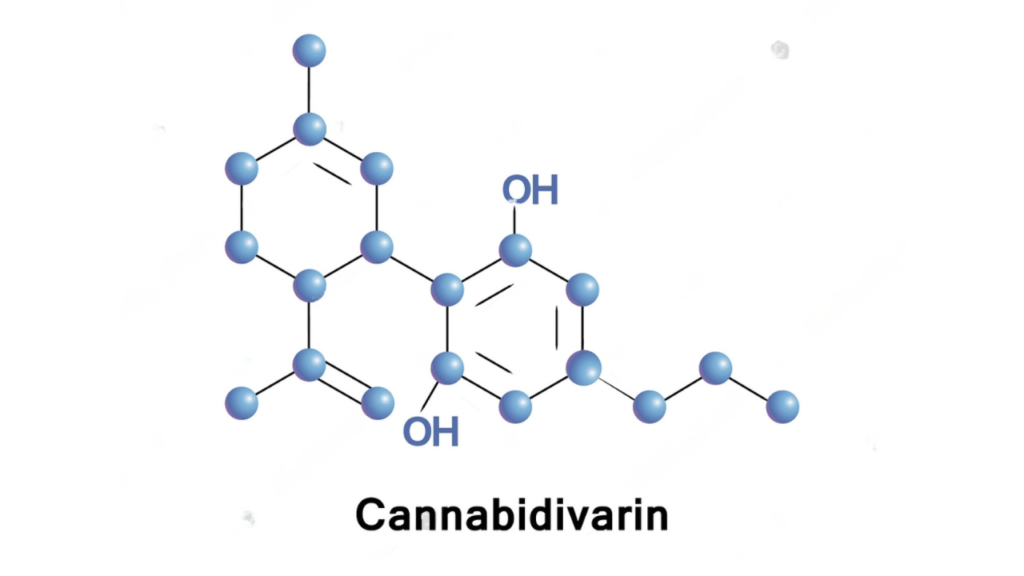
CBDV is a non-intoxicating cannabinoid that shares similarities with CBD. Step aside, THC and CBD. It’s time for the underdog to take center stage. Meet Cannabidivarin, or CBDV, a lesser-known member of the cannabinoid family that’s starting to make serious waves in the health and wellness sector. Unlike its more famous counterparts, CBDV doesn’t have a loud presence; instead, it operates quietly in the background, making it an underdog in our list of the top 22 cannabinoids. But make no mistake, despite its low profile, CBDV packs a punch regarding potential health benefits. Early research suggests promising therapeutic applications, particularly in neurology and gastroenterology. Exciting, isn’t it? Unconventional, unassuming, yet undeniably potent, CBDV is reshaping the cannabinoid narrative.
If you’re captivated by the idea of exploring the “road less traveled” in your wellness journey, read on as we unravel the mystique of CBDV.
Let’s dive into its potential therapeutic properties, its impact on health, and how it might become the next big thing in cannabinoid therapy. Are you ready to embrace the unconventional in your wellness quest? Let’s journey into the realm of CBDV.
It has been the focus of research due to its potential health benefits, including:
- Anticonvulsant properties: CBDV has shown promise as an anticonvulsant, indicating its potential use in epilepsy treatment.
- Anti-nausea effects: Research suggests that CBDV may help reduce nausea and vomiting, making it valuable for individuals experiencing these symptoms.
- Anti-inflammatory effects: CBDV has demonstrated anti-inflammatory properties, which may have applications in various inflammatory conditions.
- Neuroprotective effects: Research suggests that CBDV might reduce nerve cell activity and improve conditions like seizures, pain and inflammation.
7. Cannabigerolic Acid (CBGA): The Architect of Cannabinoids
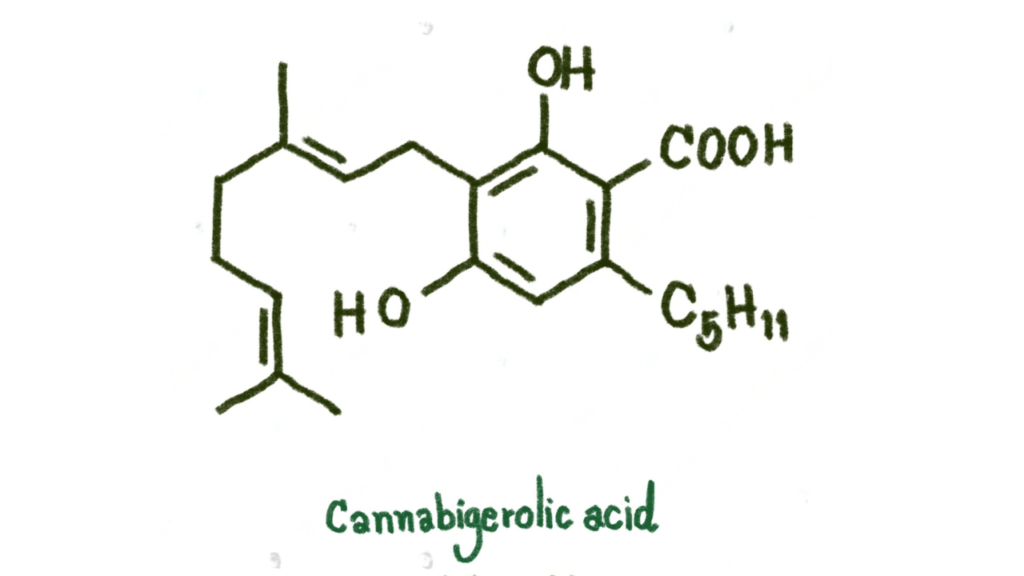
CBGA is a precursor to other cannabinoids known as the “stem cell” cannabinoid. As we chart the panorama of cannabinoids in our quest for wellness, it’s time to illuminate this important cannabinoid included in the “entourage effect”, Cannabigerolic Acid (CBGA). Often overlooked, CBGA is the architect of the cannabinoid world, the “mother” molecule that births other cannabinoids, including THC and CBD. Yet CBGA doesn’t just play a backstage role. Emerging research points to a roster of potential health benefits that could make CBGA the next big thing in cannabinoid wellness. Its potential properties range from anti-inflammatory and neuroprotective to possibly even combating metabolic disorders. Imagine a single plant compound that could hold the blueprint for a diverse range of therapeutic properties. But how does CBGA transform into other cannabinoids? What does this mean for our health? If these questions have sparked a flame of curiosity in you,
you’re in the right place. Join us as we unfold the CBGA narrative, a fascinating saga that could redefine our understanding of cannabis and its potential in health and wellness. Dive deeper, think critically, and harness the power of knowledge as we navigate the expansive world of cannabinoids and their potential, starting with the mother of them all, CBGA.
Research on CBGA is still in its early stages, but it shows potential in several areas, including:
- Antibacterial properties: CBGA has demonstrated antibacterial effects, suggesting it could help fight bacterial infections.
- Anti-inflammatory effects: CBGA has anti-inflammatory properties, indicating potential applications in inflammatory conditions.
- Neuroprotective properties: Preliminary studies suggest that CBGA may have neuroprotective effects, with further research needed on the horizon to understand its full potential.
- Potential analgesic properties: CBG possesses excellent pain-relieving properties.
8. Tetrahydrocannabivarin (THCV): The Lesser-Known Sibling with a Stellar Potential
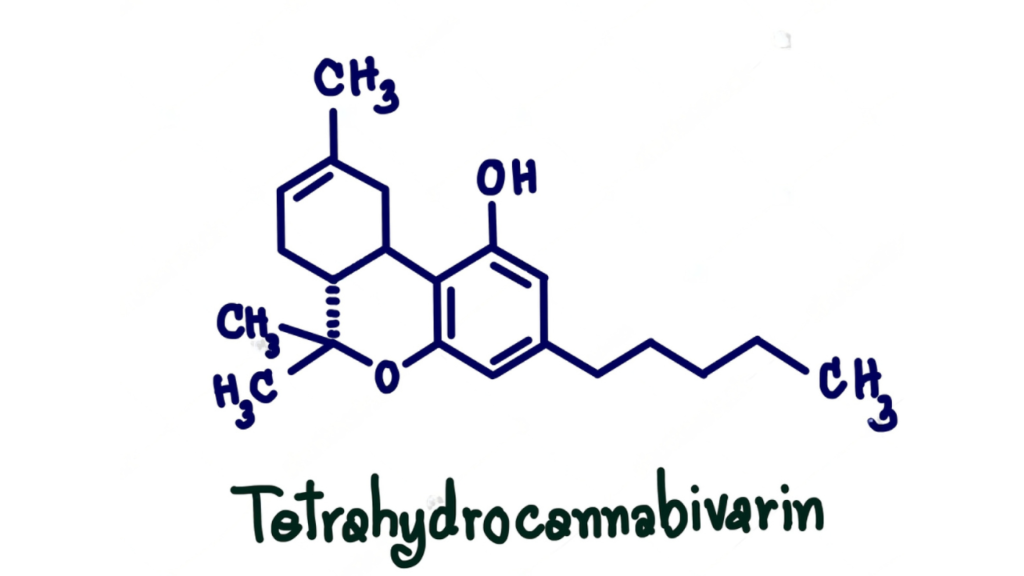
THCV is a psychoactive cannabinoid found in trace amounts in specific cannabis strains. Just when you thought you grasped the cannabinoid universe, another star twinkles, vying for your attention, meet Tetrahydrocannabivarin, or THCV, an under-the-radar cousin of THC with a promise of groundbreaking potential. While it might not have captured the limelight like THC or CBD, don’t let THCV’s relative obscurity fool you. This intriguing cannabinoid is quietly making a name for itself, not for mind-altering effects but for an exciting array of potential health benefits. Preliminary research suggests THCV may regulate blood sugar levels, reduce anxiety, and even promote bone growth. It sounds surprising, doesn’t it? As we navigate through the top 22 cannabinoids, THCV emerges as a must-know contender, a hidden gem in the treasure chest of Cannabis compounds. Stick around as we look at THCV, its distinct profile, and its potential applications. Unravel the mystery of this less-heralded cannabinoid and discover how
Could THCV be the missing puzzle piece in your wellness journey. Who knows? It might just be your next favorite cannabinoid.
THCV has demonstrated some potential health benefits, including:
- Appetite suppression: THCV may act as an appetite suppressant, potentially aiding individuals in weight management.
- Antiepileptic properties: Studies suggest that THCV may have antiepileptic effects, indicating its potential use in epilepsy treatment.
- Neuroprotective properties: Research indicates that THCV may possess neuroprotective properties, but further studies are required to understand the full range of therapeutic benefits.
- Potential diabetes management
Research Studies:
- Study 1: Appetite suppression
- Study 2: Antiepileptic properties
- Study 3: Neuroprotective properties
- Study 4: THCV shows promise as an anti-acne agent
- Study 5: Only known phytocannabinoid antagonist at the CB1 receptor
- Study 6: Symptom-relieving phytocannabinoid Δ⁹-THCV in animal models of Parkinson’s disease
9. Cannabinodiol (CBDL): Diving into the Depths of The Lesser-Known Cannabinoid
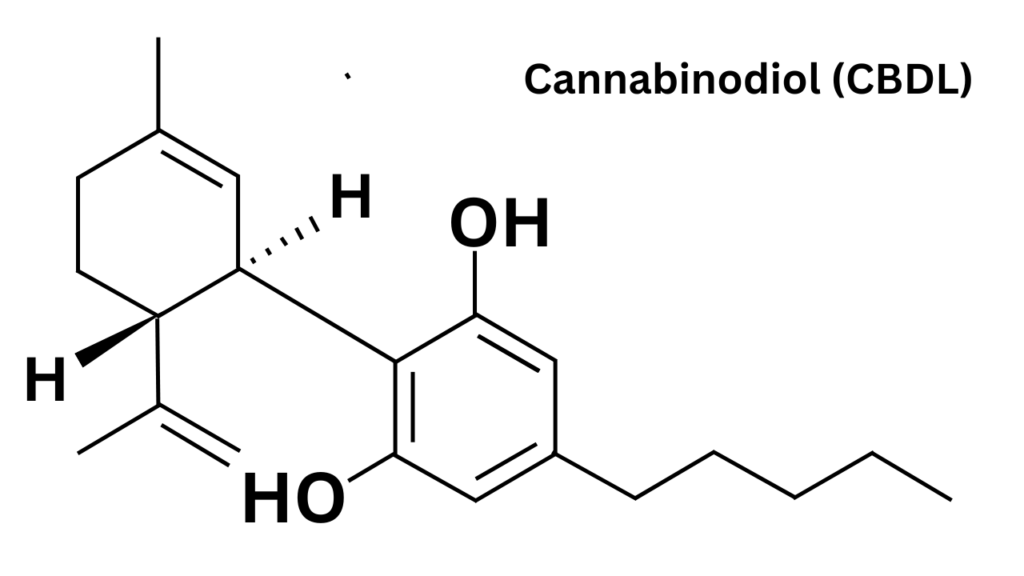
CBDL is a lesser-known cannabinoid that has gained attention for its potential therapeutic applications. In the riveting landscape of cannabinoids, certain stars shine brighter than others. While CBD and THC often steal the limelight, let’s shed light on a quieter entity, Cannabinodiol, or CBDL. As the sleeper of cinematic tales, CBDL, this lesser-known cannabinoid, might just hold the key to unfolding mysteries in the cannabinoid narrative. Scientific research on CBDL has been scarce compared to its celebrated counterparts. Yet, initial explorations hint towards an exciting potential for interaction with the human endocannabinoid system (ECS).
This interaction could open new doors to understanding pain management, anxiety alleviation, and much more. Intrigued? You’re right on track. As we continue our expedition through the top 22 cannabinoids, prepare to learn more about the understated world of CBDL. This might just be the opportunity you’ve been waiting for to broaden your horizons about the incredible diversity and potential of cannabinoids like CBDL. The most surprising secrets often lie off the beaten path.
Some of CBDL potential medical benefits include:
- Antibacterial effects: CBDL has demonstrated antibacterial properties, suggesting its potential use in combating bacterial infections.
- Anti-inflammatory effects: Studies indicate that CBDL may possess anti-inflammatory properties, making it useful in inflammatory conditions.
- Anticonvulsant properties: Research suggests CBDL may have anticonvulsant effects, indicating its potential use in epilepsy management.
10. Cannabicyclol (CBL): Unveiling This Lesser Known Cannabinoid
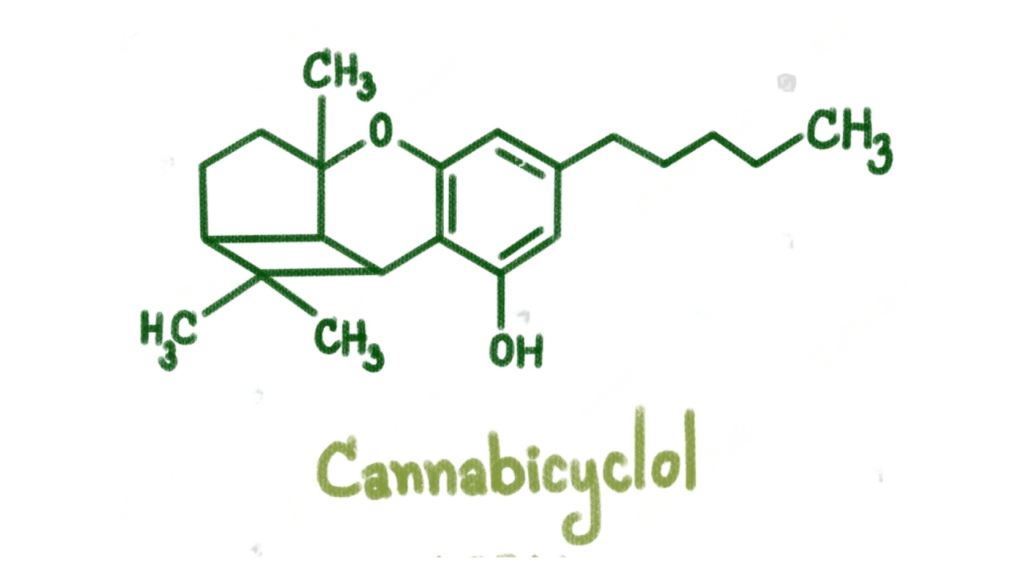
CBL is a non-intoxicating cannabinoid that has received limited scientific attention. In the grand symphony of cannabinoids, some players, like THC and CBD, are praised for their solo performances. Yet, others, like Cannabicyclol (CBL), wait patiently in the wings for their potential to be fully appreciated. As we navigate our list of the top 22 cannabinoids, we shine a light on CBL, a lesser-known but equally fascinating compound. While CBL might not headline the cannabinoid conversation today, the mysteries surrounding it make it an enticing subject of study. Discovered way back in 1964 by Korte and Sieper, CBL has been elusive, hiding its therapeutic promise behind a veil of scientific uncertainty. Preliminary studies suggest its possible anti-inflammatory role, marking a promising start to unveiling its potential. Do you feel the thrill of the unknown?
That’s what CBL brings to our cannabinoid journey. A suspenseful exploration into the less trodden paths of Cannabis science awaits you. As we explore the enigma of CBL, let’s uncover the hidden potential of this under recognized cannabinoid hero. After all, every hero deserves their time in the spotlight.
Although research is limited, CBL shows potential in several areas, including: :
- Antibacterial effects: CBL has been found to possess antibacterial properties, suggesting its potential use in fighting bacterial infections.
- Anti-inflammatory effects: Studies suggest that CBL may have anti-inflammatory properties, offering potential benefits for inflammatory conditions.
- Analgesic effects: Preliminary research indicates that CBL may exhibit analgesic effects, potentially contributing to pain relief.
- Antioxidant activity
11. Cannabielsoin (CBE): A Hidden Gem in the Cannabinoid Spectrum

CBE is a cannabinoid discovered in 1973 with limited scientific attention, lacking research on its potential benefits. Among the constellation of cannabinoids in our top 22 list, Cannabielsoin, or CBE, might not ring many bells, but don’t let its relative obscurity deceive you; this elusive compound is gradually emerging from the backdrop of cannabinoid science with promising potential.
While research on CBE is still developing, early studies hint at a potential treasure trove of health benefits yet to be fully explored. CBE shares a close connection with CBD but possesses its own unique characteristics that set it apart. Unlike CBD, CBE is not found in abundance in the cannabis plant. Instead, it emerged as a byproduct of a fascinating process catalyzed by enzymes within the body.
Considered one of the “minor cannabinoids,” CBE is a byproduct of CBD metabolism, expanding the therapeutic potential of the cannabis plant beyond the paths of its sibling THC and CBD. When CBD interacts with specific enzymes within our bodies, a transformative process occurs, leading to the formation of CBE. Does this have your attention? It should. As we navigate this intricate world of cannabinoids, the CBE narrative is brimming with anticipation and mystery. Learn more about the emerging science of CBE in your quest to illuminate potential health benefits. Gear up for an enlightening journey that may fundamentally alter your understanding of cannabis and its potential to contribute to health and wellness.
More research is required to understand the medicinal properties of CBE. Here are a few potential medical benefits: :
- Anti-inflammatory effects
- Potential analgesic properties
- Neuroprotective effects
Research Studies:
12. Cannabitriol (CBT): An Emerging Contender of the Cannabinoid Universe
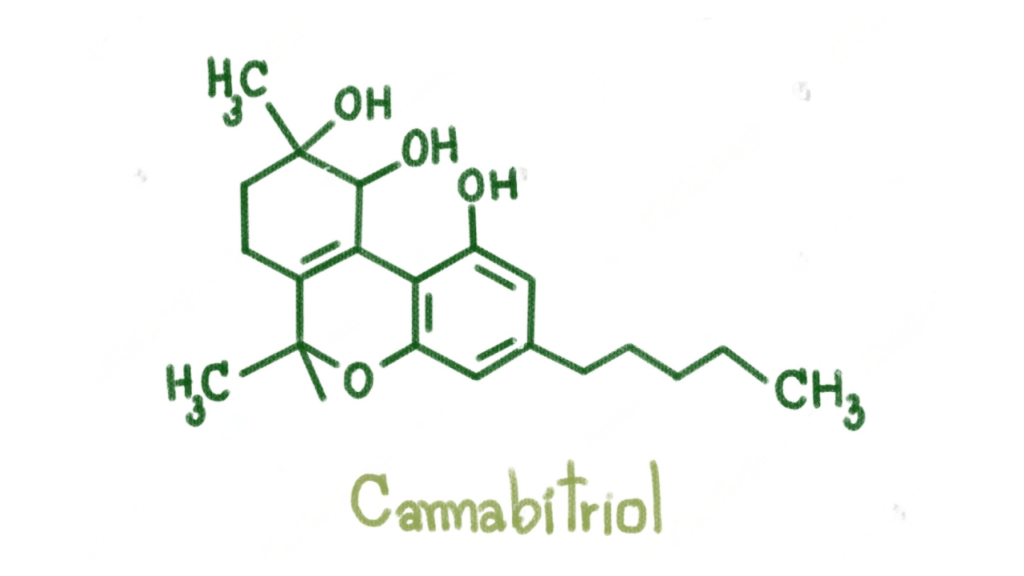
CBT is a lesser-known cannabinoid with limited scientific research. Regarding cannabis chemistry, the spotlight typically shines on household names like THC and CBD, but Cannabitriol (CBT) is a potential contender in the cannabinoid sphere. Discovered by Obata & Ishikawa in 1966, its molecular structure wasn’t established until 1976. THC and CBT have similar chemical structures. In relatively uncharted territory, CBT exemplifies the exciting frontiers of cannabinoid science that are yet to be fully explored. Research on CBT is in its infancy, with limited studies regarding its health benefits. We know CBT is found in higher concentrations in hemp products than marijuana. Initial findings point towards various applications, from neuroprotection to anti-inflammatory properties, but are inconclusive.
As part of our deep dive into the top 22 cannabinoids, some emerging theoretical potential may amplify our understanding of the collective strength of cannabinoids.
Stay tuned because the journey through the lesser-known echelons of the cannabinoid universe, starting with CBT, might continue to impress upon you the various roles of cannabinoids in wellness.
One known fact about CBT is that there are nine (9) chemical variations of the cannabinoid, one of which is cannabicitran (CBT-C). Another potential theoretical benefit is that CBT and CBT-C may reduce the negative effects of THC. Its potential health benefits have not been extensively studied, and more research is necessary to understand its medicinal value.
Some findings have shown that it may potentially provide: :
- Anti-inflammatory effects
- Potential analgesic properties
- Antioxidant activity
- May help treat marijuana abuse
Research Studies on CBT are extremely limited and inconclusive on potential medicinal benefits, but here are a few:
13. Cannabichromevarin (CBCV): A Rising Star in the Cannabinoid Cosmos
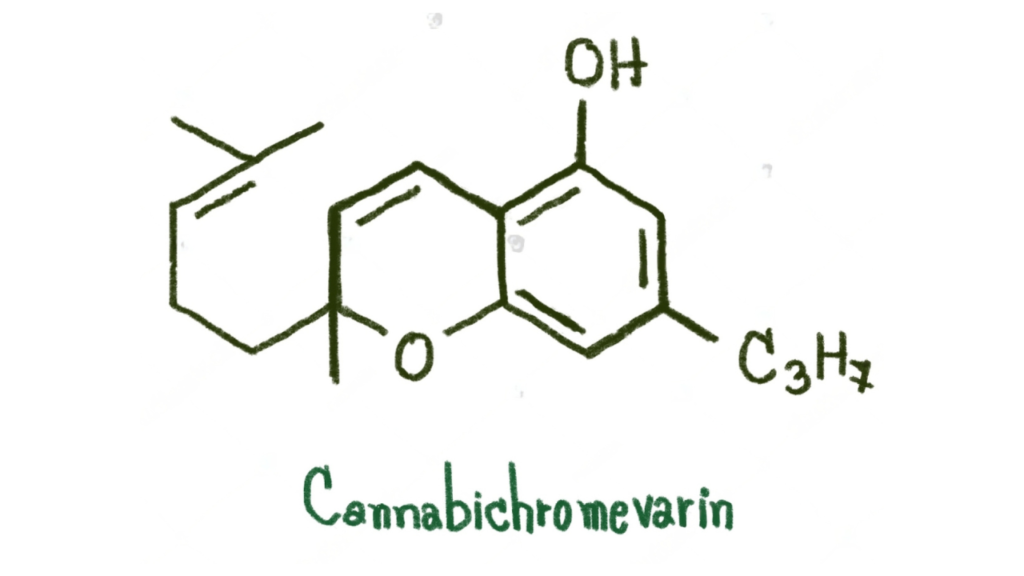
CBCV is a minor cannabinoid found in cannabis, and research on its potential health benefits is limited. Amidst the diverse constellation of cannabinoids, one star is starting to shine with a unique light: cannabichromevarin, or CBCV. While it may not be as renowned as its counterparts,
Initial research points to a trove of possibilities, from influencing inflammatory responses to potential implications for neuroprotective activities. CBCV is rapidly gaining scientific interest for its intriguing potential health benefits. Extracted from the Cannabis plant, this less-known cannabinoid quietly turns heads in the scientific community.
Unlike THC, it doesn’t have psychoactive properties, providing benefits without getting “high.” Yet, it is every bit as fascinating as its more famous siblings.
Does CBCV sound like an under-the-radar cannabinoid you’d love to know more about? As we explore the top 22 cannabinoids, join us in unearthing the therapeutic potential of CBCV. This less-celebrated but potentially potent player in the cannabinoid universe can potentially uncover hidden treasures in medical applications.
Further studies are required to determine its medicinal properties and therapeutic applications for:
- Anti-inflammatory effects
- Potential anticonvulsant properties
- Antidepressant effects
14. Cannabidivarinic Acid (CBDVA): Harnessing Its Anti-Inflammatory Might
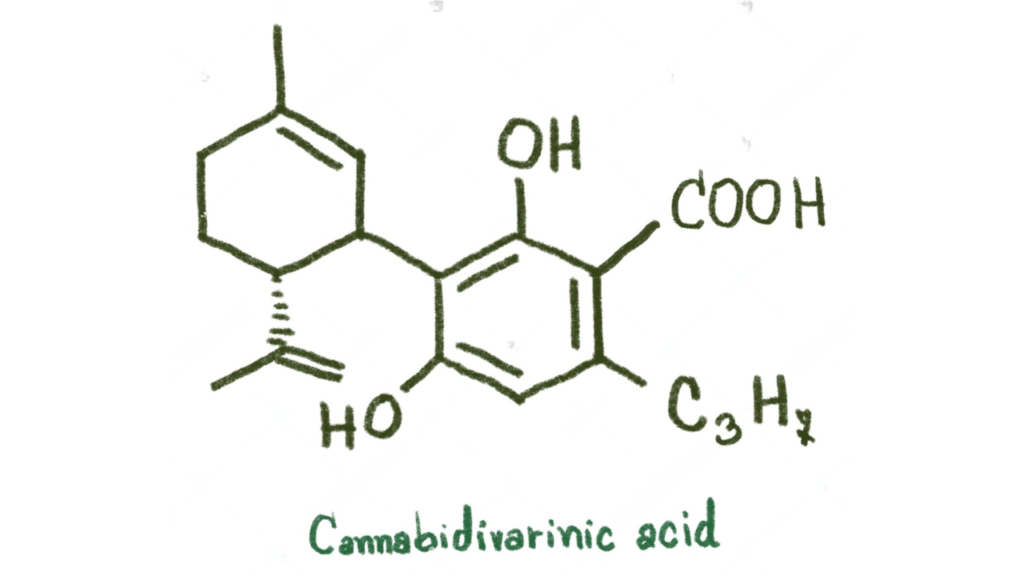
Cannabidivarinic acid (CBDVA) is the biosynthetic precursor molecule of cannabidivarin (CBDV) found in the Cannabis sativa plant. CBDVA is a non-intoxicating cannabinoid that shares similarities with CBD. As we journey through our top 22 cannabinoids, let’s pause to appreciate a lesser-known, yet no less remarkable, member of the cannabinoid family: Cannabidivarinic Acid, or CBDVA.
Shrouded in scientific intrigue, CBDVA has started to turn heads in the research community for its purported anti-inflammatory prowess. Picture this: a naturally occurring compound that could potentially soothe inflammation, the common underpinning of numerous health ailments ranging from arthritis to heart disease. CBDVA is fascinating because of its anti-inflammatory potential and its nuanced interplay within the cannabinoid family. Just as every note contributes to a symphony’s harmony, CBDVA adds to the entourage effect, enriching the overall therapeutic impact of cannabinoids.
Imagine a plant-derived molecule offering an alternative path to combat the inflammation ravaging our bodies.
Intrigued? That’s the power of cannabinoids, every bit as exciting as it is promising. Stay with us as we delve further into the science-backed potential of CBDVA, revealing a new perspective on cannabinoids and their health benefits. Prepare to be enlightened as we continue this cannabinoid expedition, possibly reshaping your approach to wellness forever.
However, scientific research on its potential health benefits is currently limited. Based on preliminary research, there seems to be therapeutic potential for epilepsy, insomnia, pain, and gastrointestinal disorders. Further studies should be conducted to explore CBDVA medicinal properties.
Some potential medical benefits are:
- Anticonvulsant properties
- Antiemetic effects
- Neuroprotective effects
- Antiepileptic
Research Studies:
- Study 1: Phytocannabinoids inhibit T-type channels with substantial effects
- Study 2: Based on the the brain–plasma ratio, CBDVA exhibits poor brain penetration
- Study 3: Anticonvulsant against hyperthermia-induced seizures in mice
- Study 4: CBDVA may assist the effects of cannabis products used for childhood epilepsy
15. Tetrahydrocannabiorcol (THCB): Decoding A Potential Maverick in Anti-Inflammatory Warfare
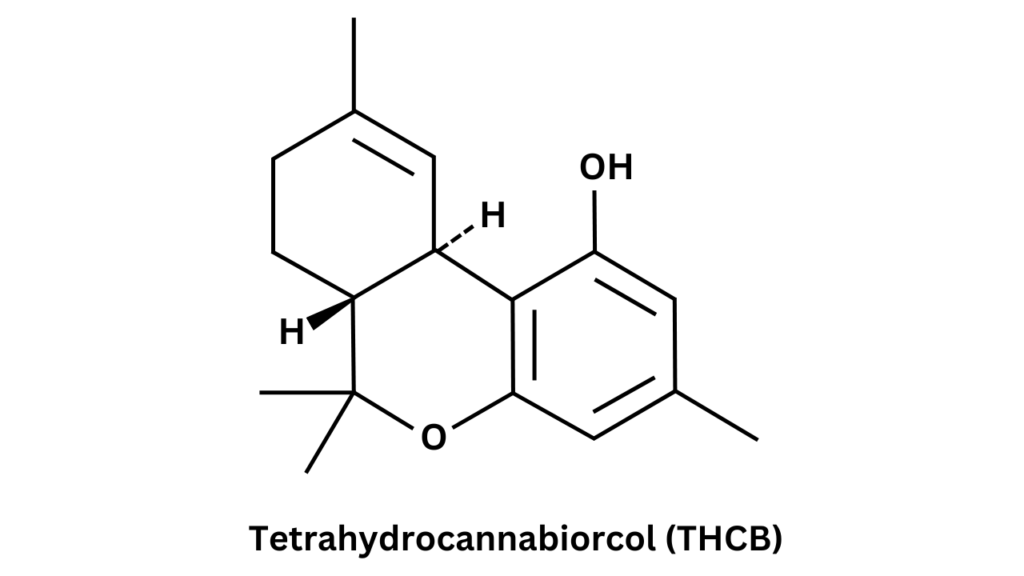
Riveting the terrain of the top 22 cannabinoids, it’s time to shed light on a less-familiar yet promising name: – Tetrahydrocannabiorcol, or THCB. Frequently overshadowed by its better-known siblings, is becoming more well-known among scientists because of its potential anti-inflammatory properties. Studies suggest that THCB might just be a rising star in inflammation combat. With chronic inflammation being a common antagonist in numerous health conditions, the implications of THCB’s potential are profound.
Can you imagine a natural compound, nestled within the Cannabis plant, playing a pivotal role in our battle against chronic inflammation? As our journey unfolds, we anticipate more research investigating this groundbreaking study and the potential ripple effects it could create for natural health solutions.
Fasten your seatbelts and stay with us as we decode the secrets of THCB. It’s not just another name in the cannabinoid family; it could be a game-changer in your pursuit of wellness. Embark on this informative exploration, and you might discover a new way to bolster your health in the face of inflammation. THCB is a minor cannabinoid with limited scientific attention, and research on its potential benefits is currently lacking. Further studies are required to gain a better understanding of its properties.
Research Studies:
- Study 1:responsible for the intoxicant activity of Cannabis sativa L
- Study 2: Injection of Δ(9)-tetrahydrocannabiorcol produced TRPA1-dependent antinociception
- Study 3: TRPA1 mediates spinal antinociception induced by acetaminophen and the cannabinoid Δ9-tetrahydrocannabiorcol
- Study 2: Δ9-tetrahydrocannabiorcol reduces nociceptive behavior in mice and activates TRPA1
16. Cannabichromevarinic Acid (CBCVA): Explore The Inflammation-Busting Cannabinoid
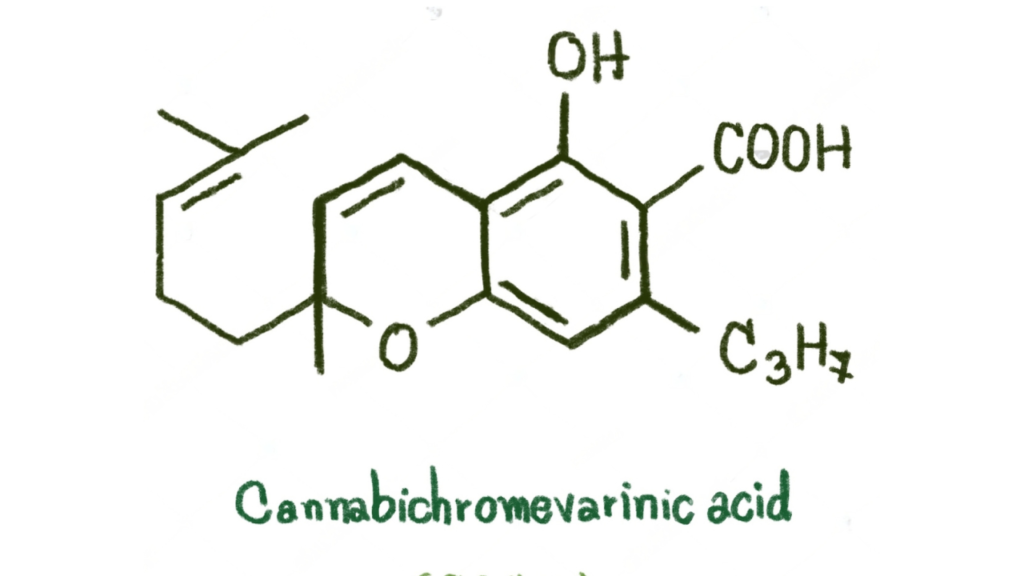
Our exploration of the top 22 cannabinoids leads us to a lesser-known yet intriguing character – Cannabichromevarinic Acid, or CBCVA. Not making mainstream headlines doesn’t diminish its potential. In fact, the “less-traveled” nature of CBCVA only adds to its allure.
CBCVA is a minor cannabinoid that has not been extensively studied for potential health benefits. Being a prominent cannabinoid compound, CBCVA actively engages the central nervous system, effectively boosting hormone functionality and maintaining a harmonious balance in appetite control, sleep patterns, mood regulation, and energy levels.
Recent studies have started highlighting CBCVA’s potential anti-inflammatory properties, prompting us to take notice. Imagine a naturally occurring compound playing a potentially critical role in the fight against chronic inflammation—the root cause of chronic health conditions.
The intricacies of CBCVA’s anti-inflammatory effects show the promise of redefining our approach to managing inflammation-related disorders. As we delve into the science-backed benefits of CBCVA, prepare to uncover the promising impacts this cannabinoid could have on human health. So, hold onto your seats as we embark on this deep dive into the potential health benefits of CBCVA. It’s a voyage of discovery that might change how you think about wellness. Your journey to understanding the world of cannabinoids is just beginning. Stick around; there’s much more to explore.
Further research is needed to determine its properties and therapeutic value. Some preliminary potential applications:
- Anti-inflammatory effects
- Potential analgesic properties
- Antifungal activity
- Anti-epileptic
- anti-convulsant
Research Studies:
17. Cannabigerovarin (CBGV): An Emerging Star With Anti-Inflammatory Power
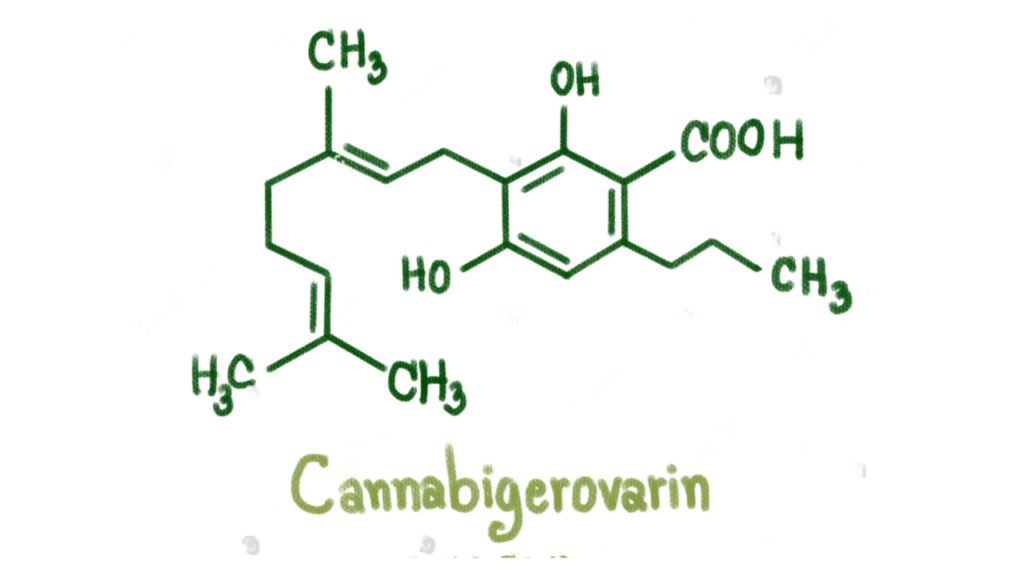
Yehiel Gaoni and Raphael Mechoulamis, two Israeli researchers, made the discovery of CBGV in 1964. It is a non-psychotropic phytocannabinoid derived from hemp. Regarding the lesser-known cannabinoids, Cannabigerovarin, a derivative of cannabigerol, or CBGV, is a name that’s been creating ripples in the scientific community. As part of our tour through the top 22 cannabinoids, it’s time to turn our lens towards CBGV, a compound emerging as a powerful player in the anti-inflammatory game. Recent studies hint at CBGV’s potential ability to moderate inflammation, a ubiquitous culprit behind countless health ailments.
What sets CBGV apart? Its unique modus operandi lies in its interaction with the body’s endocannabinoid system, potentially leading to a natural and balanced response to inflammation. With CBGV, we may just be scratching the surface of an entirely new way to combat inflammation and associated health challenges.
The prospect of a novel, plant-based approach to managing inflammation, is extremely intriguing. Continue reading about CBGV and explore how it may fit into your wellness journey of natural health solutions.
Research on its potential benefits is currently limited, and further studies are required to explore its properties fully.
Here are some preliminary findings that need to be explored further by researchers:
- CBGV may help relieve painful intraocular pressure
- May help treat acne.
- CBG and CBGV combined showed shrinkage and prevented the development of metastases in cancerous cells, halting the progression of the cell cycle.
- Anti-inflammatory
- Antibacterial
- Neuromodulatory effects
18. Cannabigerovarinic Acid (CBGVA) Shining a Light on A Cornerstone Cannabinoid with Anti-Inflammatory Potential

Here’s a name that might not roll off your tongue but promises to make a resounding impact on cannabinoid science – Cannabigerovarinic Acid, or CBGVA. CBGVA is a lesser-known cannabinoid that has not been extensively studied, but scientists believe It helps metabolize CBD.
As one of the lesser-known members of our top 22 cannabinoids list, CBGVA is not merely an under-the-radar compound. It’s gaining ground as a potential cornerstone in cannabinoid-based therapies, particularly for its purported anti-inflammatory properties. Imagine a natural molecule, buried deep within the complex structure of the Cannabis plant, that could potentially alleviate inflammation – a common villain in so many health conditions. The exciting part? We’re only scratching the surface of CBGVA’s potential.
Our exploration of this fascinating cannabinoid will delve into the scientific studies unearthing its anti-inflammatory prowess. As we journey through the pantheon of cannabinoids, CBGVA’s chapter promises to be intriguing. Prepare to challenge your existing knowledge and embrace the potential that CBGVA and its fellow cannabinoids hold. Who knows? This insightful journey might inspire your next steps toward a more natural, balanced wellness journey.
Continued research is necessary to determine its medicinal properties and therapeutic applications.
Preliminary data suggests these potential medicinal benefits:
- Anti-inflammatory effects
- Analgesic properties
- Antimicrobial activity
- Anticonvulsant properties
19. Tetrahydrocannabinovarinic Acid (THCVA): Uncharted Territory For This Trailblazer With Anti-Inflammatory Benefits

Venturing deeper into the fascinating realm of cannabinoids, we come across a lesser-known yet compelling constituent of the Cannabis plant, Tetrahydrocannabivarinic Acid, or THCVA the precursor of THCV. While it might not enjoy the same spotlight as THC or CBD, THCVA is carving out a significant role in the medicinal cannabis narrative. THCVA is a minor cannabinoid found in cannabis, and emerging research is shedding light on its potent anti-inflammatory capabilities, revealing THCVA as a potential warrior against chronic inflammation—a leading cause of chronic health conditions. The carboxylic acid precursor to THCV (a form of delta-9 tetrahydrocannabinol THC)is THCVA, This naturally occurring compound might help mitigate the harmful effects of inflammation without the unwanted side effects of synthetic drugs.
It sounds compelling, doesn’t it? In our detailed exploration of the top 22 cannabinoids, THCVA’s potential contributions cannot be overlooked. This exploration could be a turning point in your quest for holistic health solutions, with THCVA being a potential new ally in your wellness journey. THCVA’s potential health benefits need to be extensively studied for conclusive evidence of its health benefits. Further research is needed to understand its beneficial properties.
Here are some potential medical applications:
- Potential anticonvulsant properties
- Appetite suppression
- Anti-inflammatory effects
- Potential to fight obesity or Type II Diabetes.
20. Cannabidihexol (CBDH): Another cannabinoid For Pain

CBDH is a lesser-known cannabinoid with limited scientific research. Amidst the rich tapestry of cannabinoids, there lies a potential gem known as Cannabidihexol, or CBDH. Notably, emerging research suggests that CBDH could be a potent force in the battle against inflammation. Imagine a world where this naturally occurring compound could relieve chronic inflammation, a condition often linked with everything from heart disease to arthritis. Sounds remarkable, right? Hold onto that sense of wonder as we journey through our list of the top 22 cannabinoids. As we dig deeper into CBDH’s potential, prepare to traverse the exciting terrain of innovative research and emerging possibilities.
Let’s learn how CBDH might revolutionize how inflammation is treated, improving countless lives in the process. Stay with us as we unlock the fascinating potential of CBDH in your quest for optimal health and wellness. The journey is just beginning!
Its potential health benefits have not been extensively studied, and more research is required to understand its potential uses in medicine.
21. Cannabidinolic Acid (CBDA)

CBDA is a precursor to CBD and has gained attention for its potential health benefits.
This naturally occurring compound could potentially act as your body’s personal firefighter, quelling the flames of inflammation right at their source. Welcome to the world of CBDA, a non-intoxicating cannabinoid that is rapidly becoming a potential key component of anti-inflammatory treatments.
After being overshadowed by its decarboxylated derivative, CBD, a number of encouraging studies indicate that CBDA may finally get the attention it deserves.One research study reviews the anti-inflammatory effects of CBDA, revealing intriguing possibilities. Could CBDA be the natural, non-psychoactive solution to chronic inflammation that many seek? As we delve deeper into exploring the top 22 cannabinoids, don’t miss this deep dive into CBDA. The results of an interesting study might just reshape your understanding of cannabinoids and their health benefits.
Ready to continue your journey down this path of discovery and redefine wellness? Stay tuned as we unpack the potential of CBDA, and together, we’ll explore how this unique cannabinoid could potentially transform your health journey.
Some potential benefits include:
- Anti-inflammatory properties: CBDA has shown anti-inflammatory effects, suggesting its potential use in inflammatory conditions.
- Antiemetic effects: Research suggests that CBDA may have antiemetic properties, making it helpful in reducing nausea and vomiting.
- Potential anticancer properties: Studies indicate that CBDA may have anticancer properties, but further research is needed to understand its full potential in cancer treatment.
- Potential analgesic properties
- Anxiolytic-like effects
22. Cannabichromenic Acid (CBCA)

CBCA is a precursor to CBC and has shown potential in various health applications.
In the complex puzzle of cannabinoids, Cannabichromenic Acid (CBCA) might seem like an obscure piece. But recent studies are proving it to be a piece that fits right into the heart of a comprehensive wellness strategy. Through our journey exploring the “Top 22 Cannabinoids and Their Potential Health Benefits,” CBCA stands out for its promising anti-inflammatory properties. Imagine a plant-derived compound naturally working in harmony with your body, potentially easing inflammation and relieving those battling chronic inflammatory conditions. Researchers have been exploring the potential, and the findings are impressive. Curious to know how CBCA might offer a gentle, natural alternative to managing inflammation?
Hold tight because we’ll dive into these compelling findings. Let’s uncover the scientific revelations around CBCA’s potential anti-inflammatory prowess and the potential implications for your wellness journey. The rabbit hole of cannabinoids runs deep, and with every layer we peel back, there’s more intriguing knowledge waiting to be discovered.
Some potential benefits include:
- Anti-inflammatory effects: CBCA has demonstrated anti-inflammatory properties, indicating its potential use in inflammatory conditions.
- Antibacterial effects: Research suggests that CBCA may possess antibacterial properties, offering potential benefits in combating bacterial infections.
- Potential anticancer properties: Preliminary studies indicate that CBCA may have anticancer properties, but further research is needed to understand its full potential in cancer treatment.




2 Responses
How are you doing, everyone? This is just a quick note to let you know that I truly love reading the pieces on this website, and I appreciate how frequently they are updated. It is filled with pleasant things.
I have read some excellent stuff here Definitely value bookmarking for revisiting I wonder how much effort you put to make the sort of excellent informative website